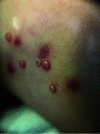The Identification and Treatment of Common Skin Infections
- PMID: 35984712
- PMCID: PMC10496455
- DOI: 10.4085/1062-6050-0142.22
The Identification and Treatment of Common Skin Infections
Abstract
Skin conditions are a common problem addressed by medical providers. Up to 25% of individuals in the United States will seek attention for these conditions each year. The same problem occurs in the athletic training room, where athletes with infectious skin conditions can be seen. Most conditions are simple and can be treated without concern for spread to susceptible athletes. However, others can be quite serious and spread rapidly through a team and opponents during competition. Knowledge of the different types of skin infections is necessary to help treat these athletes and prevent spread to others. With proper diagnosis and treatment, certified athletic trainers can keep the athlete off the field of play for a minimum period and prevent transmission.
Keywords: Folliculitis; abscess; contact sports; herpes; impetigo; molluscum contagiosum; tinea; wrestling.
© by the National Athletic Trainers’ Association, Inc.
Figures







Similar articles
-
Infectious Disease in Contact Sports.Sports Health. 2019 Jan/Feb;11(1):47-58. doi: 10.1177/1941738118789954. Epub 2018 Aug 14. Sports Health. 2019. PMID: 30106670 Free PMC article. Review.
-
More Than Skin Deep: Dermatologic Conditions in Athletes.Sports Health. 2023 Jan-Feb;15(1):74-85. doi: 10.1177/19417381211065026. Epub 2022 Jan 17. Sports Health. 2023. PMID: 35034516 Free PMC article. Review.
-
Infectious diseases of the skin in contact sports.Adv Clin Exp Med. 2020 Dec;29(12):1491-1495. doi: 10.17219/acem/129022. Adv Clin Exp Med. 2020. PMID: 33389840 Review.
-
Tatami Mats: A Source of Pitted Keratolysis in a Martial Arts Athlete?Acta Dermatovenerol Croat. 2018 Apr;26(1):68-70. Acta Dermatovenerol Croat. 2018. PMID: 29782305 Review.
-
Cutaneous community-acquired methicillin-resistant Staphylococcus aureus infection in participants of athletic activities.South Med J. 2005 Jun;98(6):596-602. doi: 10.1097/01.SMJ.0000163302.72469.28. South Med J. 2005. PMID: 16004165
Cited by
-
Two Thematic Issues on Diversity, Equity, Inclusion, and Access in Athletic Training: Past, Present, Future.J Athl Train. 2024 Apr 1;59(4):329-330. doi: 10.4085/1062-6050-1002.24. J Athl Train. 2024. PMID: 38662444 Free PMC article. No abstract available.
References
-
- Number of participants in high-school wrestling in the United States from 2010/2011 to 2021/2022, by gender. Statista Research Department. Accessed July 14, 2022. https://www.statista.com/statistics/268028/participation-in-us-high-scho...
MeSH terms
LinkOut - more resources
Full Text Sources
Medical

